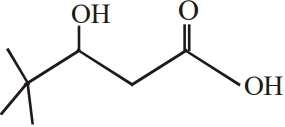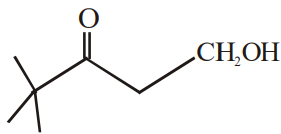Chemistry-
General
Easy
Question



- None of these



The correct answer is: 
Related Questions to study
chemistry-
What will be the most probable product when compound ‘X’ is treated with two equivalents of NaOH,

What will be the most probable product when compound ‘X’ is treated with two equivalents of NaOH,

chemistry-General
chemistry-
Aniline reacts with mixed acid (conc. HNO3 and conc. H2SO4 ) at 288 K to give P (51%), Q (47%) and R (51%), Q(47%) and R (2%). The major product(s) of the following reaction sequence is/are

Aniline reacts with mixed acid (conc. HNO3 and conc. H2SO4 ) at 288 K to give P (51%), Q (47%) and R (51%), Q(47%) and R (2%). The major product(s) of the following reaction sequence is/are

chemistry-General
chemistry-
The major product of the following reaction is

The major product of the following reaction is

chemistry-General
chemistry-
In the following reaction sequences V and W are respectively : 

In the following reaction sequences V and W are respectively : 

chemistry-General
chemistry-
Given Kcal
Kcal  Kcal
Kcal  Kcal the heat of formation of methane in Kcal will be-
Kcal the heat of formation of methane in Kcal will be-
Given Kcal
Kcal  Kcal
Kcal  Kcal the heat of formation of methane in Kcal will be-
Kcal the heat of formation of methane in Kcal will be-
chemistry-General
maths-
A set of (2n + 1) elements is given. The no. of subsets of the set which contain atmost n elements -
A set of (2n + 1) elements is given. The no. of subsets of the set which contain atmost n elements -
maths-General
chemistry-

 under Hofmann conditions will give :
under Hofmann conditions will give :

 under Hofmann conditions will give :
under Hofmann conditions will give :
chemistry-General
chemistry-
 Which step is rate determining ste
Which step is rate determining ste
 Which step is rate determining ste
Which step is rate determining ste
chemistry-General
chemistry-
 Which reagent (X) is used to convert I to II
Which reagent (X) is used to convert I to II
 Which reagent (X) is used to convert I to II
Which reagent (X) is used to convert I to II
chemistry-General
chemistry-
An organic compound A upon reacting with NH3 gives B. On heating B gives C. C in presence of KOH reacts with Br2 to given CH3CH2NH2 . A is :
An organic compound A upon reacting with NH3 gives B. On heating B gives C. C in presence of KOH reacts with Br2 to given CH3CH2NH2 . A is :
chemistry-General
Maths-
If r, s, t are prime numbers and p, q are the positive integers such that the LCM of p, q is  , then the number of ordered pair (p, q) is-
, then the number of ordered pair (p, q) is-
Be careful about selecting the r s and t for this particular problem. Because number ways for each selection of r, s and t there are 3 cases. Because there are two values given
p, q . Hence to calculate the total number of ways is to multiply the number of ways for r, number of ways for s and number of ways for t. So, in this way to solve this particular type of problem.
If r, s, t are prime numbers and p, q are the positive integers such that the LCM of p, q is  , then the number of ordered pair (p, q) is-
, then the number of ordered pair (p, q) is-
Maths-General
Be careful about selecting the r s and t for this particular problem. Because number ways for each selection of r, s and t there are 3 cases. Because there are two values given
p, q . Hence to calculate the total number of ways is to multiply the number of ways for r, number of ways for s and number of ways for t. So, in this way to solve this particular type of problem.
Maths-
A rectangle has sides of (2m – 1) & (2n – 1) units as shown in the figure composed of squares having edge length one unit then no. of rectangles which have odd unit length –

A rectangle has sides of (2m – 1) & (2n – 1) units as shown in the figure composed of squares having edge length one unit then no. of rectangles which have odd unit length –

Maths-General
chemistry-
Observe the esterification mechanisms for primary and tertiary alcohols
Type-1: 

Type-2: 
Mechanism: 

In the above reaction (P) and (Q) are respectively :
Observe the esterification mechanisms for primary and tertiary alcohols
Type-1: 

Type-2: 
Mechanism: 

In the above reaction (P) and (Q) are respectively :
chemistry-General
physics-
Two identical samples of a gas are allowed to expand (i) isothermally (ii) adiabatically work done is

Two identical samples of a gas are allowed to expand (i) isothermally (ii) adiabatically work done is

physics-General
physics-
A thermodynamic system is taken from state A to B along ACB and is brought back to Along BDA as Shown in the PV diagram. The net work done during the complete cycle is given by the area.

A thermodynamic system is taken from state A to B along ACB and is brought back to Along BDA as Shown in the PV diagram. The net work done during the complete cycle is given by the area.

physics-General



